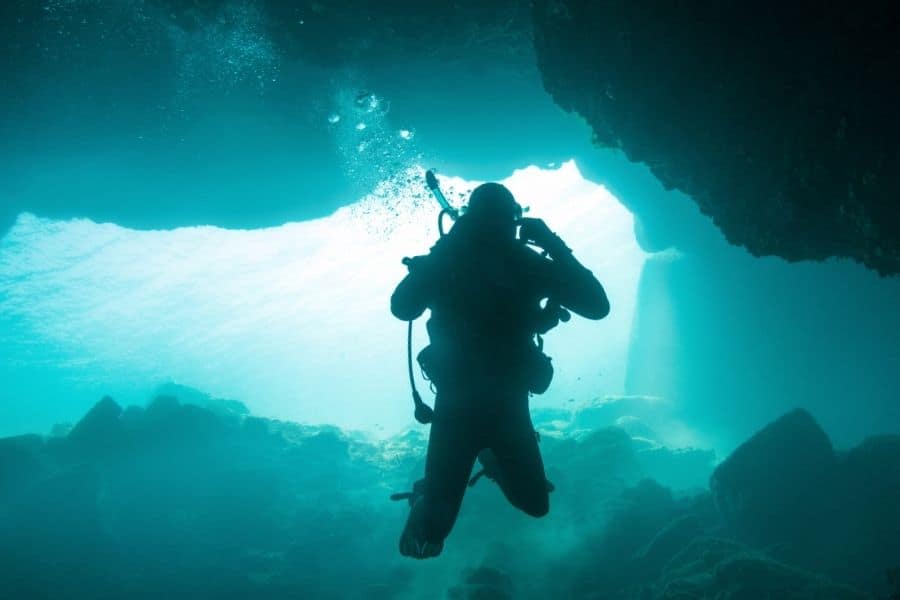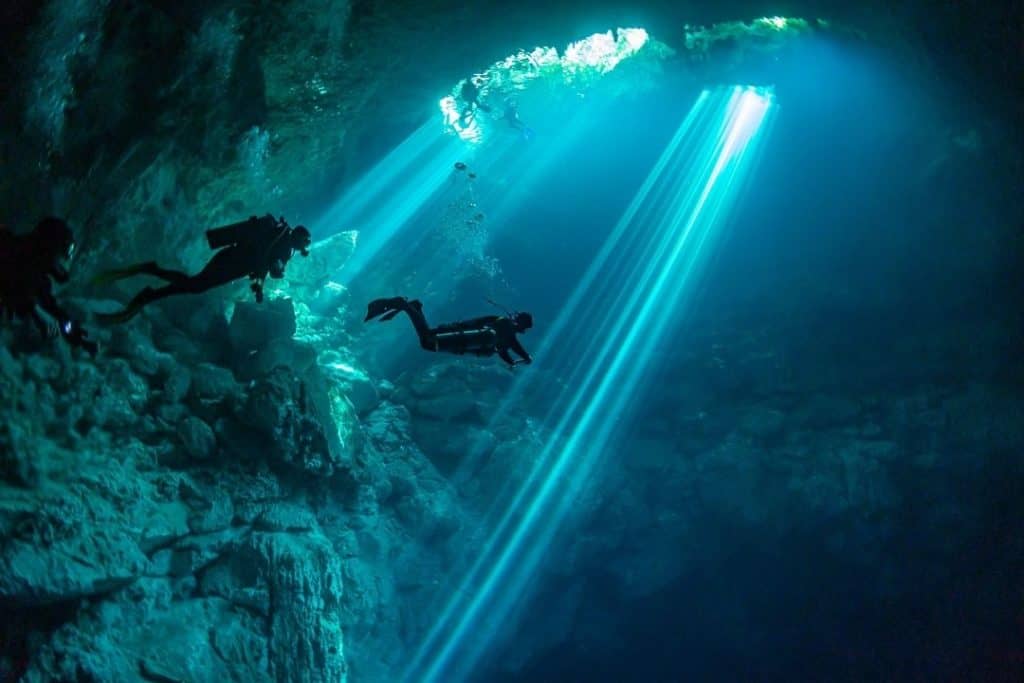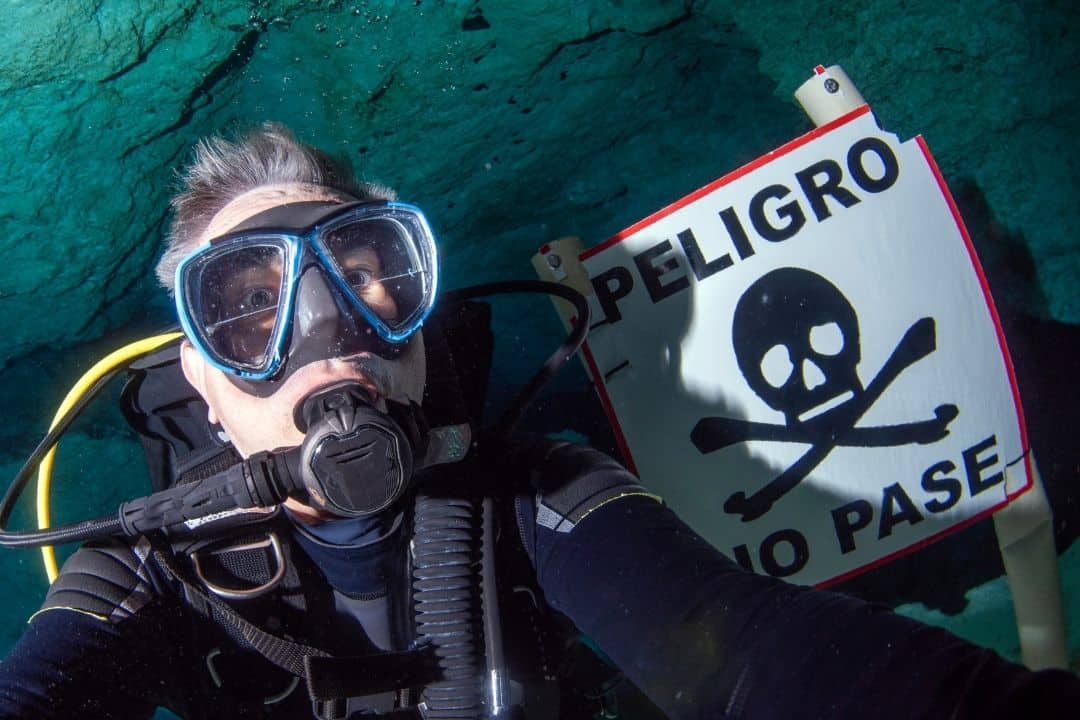You are diving along a wall along a reef, up ahead of you, a few large fish disappear into the wall.
As you reach that spot, you see a large opening. It is a cave! Should you enter or not?
Caving diving is perhaps the most advance form of scuba diving.
What is cave diving?
Cave diving is scuba diving with an overhead environment. There is no direct access to the surface, and little or no natural light. Caves can offer stunning formations and unusual marine life.
While the though of entering an underwater cave may be enticing, cave diving is dangerous and should only be done by someone trained to do so and who has the proper cave diving equipment with them.
Here is an overview of what you can expect to become a caver.
Cavern VS Cave Diving

To most people the terms cavern and cave mean the same. Commonly large open caves are called caverns.
There are many caverns around the world that are tourist attractions.
A scientist might tell you that a cavern is a cave formation formed naturally in soluble rock with stalagmites and stalactites. Scuba divers have a different meaning all together.

To the scuba diver, both a cavern and a cave are overhead environments, locations that you can not go directly to the surface.
What is the difference between cavern diving and cave diving?
Cavern diving is where you can see the entrance and the light of it, while cave diving is when you do not see or have direct access to the exit and surface.
This is also called the direct-sunlight zone. If it is not pitch black but you can not see the exit then you are in what is called the ambient-light zone and have entered a cave.
If you go in further you will be in a zone of total darkness and will need to rely on your lights.
Cavern diving is considered a recreational diving specialty, very similar to a penetration wreck dive.
Both are overhead environments, limited to the direct-sunlight zone and have a linear distance limit to the surface of 130 feet (ca. 40 m).
If you are not a certified cavern diver, you may still be able to dive a cavern as an adventure dive under the supervision of a certified instructor.
To become a cavern instructor, they must be a certified cave diver.
Having a cavern diving specialty certification is required to become a cave diver.
Cave Diving

Cave diving is a technical diving specialty, often consider an extreme sport and requires above average skills.
Only a very small percentage of Open Water Divers will continue their skill development and training to become a caver. It is not something every diver will aspire too. If you are uncomfortable in the dark or confined spaces this might not be for you.
Once you enter the zone of total darkness, you will only be able to see what is shown by your light.
However, there are those who are up to the challenge.
Cave diving can expose you to amazing underwater formations not seen elsewhere and marine life that has adapted to living in total darkness.
The challenges that can occur in cave diving came to light for many people in June and July 2018 with the Tham Luang cave rescue.
The world watched as the best cave divers in the world pulled off a difficult rescue. The current documentary, “The Rescue” gives some behind the scene insight to the amazing efforts.
That rescue was an extreme case. As with any other aspect of diving, you will find cave dives that are suitable for different level of skill developments.
You will find caves that are very open and easy to maneuver with a wide cave entrance, as well as those that are you can barely fit through and reserved for trained cave divers.
Florida and Mexico has some of the best fresh water caves systems in the world.

You can find a complete guide to the mexican cenotes cave systems in our cenote diving guide.
The Bahamas is a destination with numerous salt water caves.
In reality, underwater caves are more common than most people realize and cave diving sites are found around the world.
The skills needed to cave dive are really not that difficult, they just need to be honed very well. Buoyancy control is often cited as the most needed skill. Technical diving skills are also a must.
A twin tank setup is the most common and many caves are best dived with tri-mix. Side-mount diving with two tanks is also found.
Certification For Cave Divers
There are hundreds of recreational and technical diving accreditation agencies around the world.
The number that do cave diving accreditation drops to about a dozen. Many of those are small and regional. The most recognized are:
- Technical Diving International – TDI,
- Global Underwater Explorers – GUE
- International Association of Nitrox and Technical Divers – IANTD
- Scuba Schools International – SSI
- Rebreather Association of International Divers – RAID
Cave diving, like recrational and technical diving themselves, is a progressive training program.

You start with a basic cave diving training course that expands on the skills you already know and the knowledge you applied in cavern diving.
As you hone your skills, you can take more advanced courses with different aspects of caves until you reach a full cave diving certification.
Even with this certification there may be other courses you may want to take to tackle certain caves. Examples may be dry suit diving or using a Diver Propulsion Vehicle.
While each accreditation agency sets their own requirement to start training, there is a general level of expectations. Most commonly you will find the agencies will be looking for:
- Diving experience. Some agencies will accept 25 dives but 75 to 100 is more common.
- Advance Open Water Certification
- Cavern diving certification and experience. You will need to have experience in overhead environments and the use of reels. Most agencies will include wreck diving with penetration as examples of experience and training.
- Deep diving experience. Even if you are not looking for deep caves, the concepts learned and practices on deep dives apply well to the linear distance concepts of cave diving.
- Technical and decompression diving experience. Most cave dives are done with technical configurations. If you are not a tech diver, it may not be a problem. Some agencies have introduction to cave diving courses that includes cave training and basic tech diving.
Are You Ready For Cave Dives?
I think most divers find it very difficult to pass by the mouth of a cave or cavern and not want to take a fast look around.
When we do take that peak, the question becomes how far should we go?
Taking a cavern course and introductory cave diving courses are a great way to answer that question.
It is also a great way to see if cave diving is for you and to help you determine if your skills are up to the task.
Have a favorite cavern or cave? Lets us known by adding a comment.
